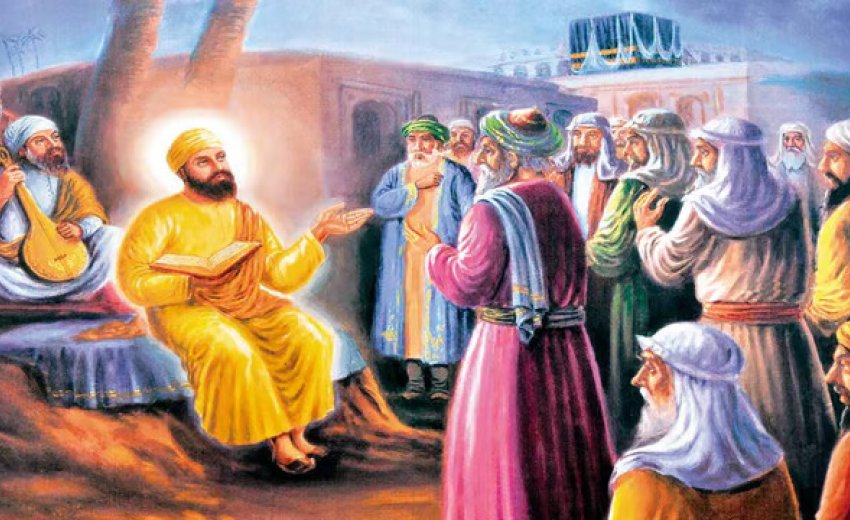Mian Mir stands as a symbol of unity, tolerance, and love, revered in both Sufi and Sikh traditions for his remarkable contributions.
Located in the heart of Lahore is the revered shrine of Hazrat Mian Mir, a prominent Sufi saint of the Qadariyyah Sufi order. Mian Mir, who arrived in Lahore at the age of 28, dedicated his life to the city, advocating for the philosophy of the "unity of existence." His teachings transcended societal barriers, earning him widespread admiration and reverence from people of all backgrounds and faiths. His demise in 1635 marked the end of a life devoted to fostering communal harmony and spiritual enlightenment. The shrine, nestled within the bustling streets of Lahore, serves as a sanctuary for the marginalised, offering free shelter and meals, particularly on Thursdays. This act of generosity reflects the saint's enduring legacy of compassion and inclusivity, resonating with the timeless values of service and unity.
Thursday evenings hold special significance for Sufis, as explained by Ghulam Fareed, a Qawwal vocalist who frequents the shrine. Alongside fellow Qawwals, he finds solace and a sense of belonging through his performances. “This shrine has given us an identity,” he expressed. For Fareed and many others, the act of singing at the shrine is not merely a musical endeavor but a deeply spiritual practice that connects them to their heritage and community. Through their devotion and artistry, they honor the traditions of Sufism and celebrate the teachings of love, unity, and devotion.
Message of peace
The Qawwals find solace and sustenance through their performances. Through conversations with several Qawwals, one uncovers a deeper purpose behind their craft beyond mere financial gain. For them, Sufi singing transcends the boundaries of mere entertainment; it becomes a conduit for spreading the profound message of unity and harmony, intrinsic to Sufi philosophy.
Each Thursday, the shrine's courtyard transforms into a stage where Qawwals pour their hearts out in melodious devotion, accompanied by the rhythmic claps and sways of the gathered audience. Amid the intoxicating aroma of roses and local incense, offerings of sweets and other delicacies are shared among the devotees both within and outside the shrine, fostering a sense of communal bond. The culinary delights specific to Sufi shrines, such as qatlaammay or desi pizza and doodh badam or milk with almonds are a cherished tradition at the Mian Mir shrine in Lahore. It adds to the richness of the spiritual experience for all who partake.
Outside the shrine, vendors gather, offering a variety of tasty treats like dahi baray, chaat, sharbat, and samosas to visitors. Among them is Akbar Shakir, a samosa vendor, who expresses a sense of belonging in the bustling streets surrounding the shrine rather than in the upscale areas of Lahore. He finds comfort and familiarity in the lively atmosphere where people from all walks of life come together, forming a vibrant community centered around shared traditions and cultural practices.
For Akbar and many others, these streets hold a special significance, representing a sense of connection and belonging that transcends economic divides and social boundaries.
Women form a significant portion of the devotees at the shrine. Sakeena, a 32-year-old visitor, shared her experience, "I was sick for two years. I went to many doctors and hakeems but no one knew what my problem was. I took medicines but nothing worked. Then one day, my mother asked me to go to the shrine and pray. I am much better since then. I believe that Aulia (friends of God) have the power to make things work for you,”
The Mughal connection
During the Mughal era, the shrine of Mian Mir was a popular destination for Mughal royals and nobility, including Dara Shikoh, the son of Emperor Shah Jahan. Dara Shikoh was renowned for his commitment to social harmony and interest in mysticism. He commissioned the construction of a mausoleum for Mian Mir after the saint's passing. His deep appreciation for spiritual teachings led him to write extensively on Sufism and even delve into Hindu scriptures like the Bhagavad Gita. His book, Sakinatul Aulia, pays homage to Mian Mir's life and teachings.
Dara Shikoh's intellectual pursuits reflected his vision for a diverse and inclusive society, a vision as relevant then as it is today. However, his brother Aurangzeb, a staunch religious conservative, seized power by imprisoning their father and ultimately having Dara Shikoh executed. Despite this tragic end, Dara Shikoh's legacy as a proponent of harmony and understanding among different communities endures, echoing the ideals of Emperor Akbar's Sulh-e-Kul, or "Peace with all".
Sufi-Sikh influence
Many Sikh pilgrims also visit the shrine. While most of them are from Pakistan, some of them also visit the holy shrine from India. Usually, the Sikh pilgrims visit the shrine during Guru Nanak Dev Ji’s gurpurab. One of the visitors, Diljeet, who was visiting from Ferozepur in Punjab, India, said, “To us, Mian Mir sahib is as divine as the saints of Sikhism.”
“Sufis and gurus and the messages they brought transcend geographical and cultural boundaries,” said Gursavek, another devotee. “They are beacons of light,” he added.
Friends across religions
Mian Mir stands as a symbol of unity, tolerance, and love, revered in both Sufi and Sikh traditions for his remarkable contributions. Historically, he played an important role in the establishment of theHarmandir Sahib, fondly known as the Golden Temple. Legend has it that Mian Mir journeyed from Lahore to Amritsar at the invitation of Guru Arjan Dev, the fifth Sikh guru. Their relationship was marked by profound mutual respect, transcending religious boundaries to embrace the shared essence of humanity.
In Sufi philosophy, the essence of life lies in recognizing the divine within oneself, regardless of one's background. Thus, the Harmandir Sahib serves not only as a spiritual centre but also as a cultural nexus for the people of Punjab, promoting self-realization and communal harmony. The term "gurudwara," meaning "the guru's door," encapsulates its significance as a gateway to spiritual enlightenment and collective growth.
Looking at the light of life: Guru Granth Sahib
The Guru Granth Sahib, the sacred scripture of Sikhism, contains the writings of revered Sufi saints like Baba Fareed from the Chishtiyyah Sufi order. It is a clear indication of how the holy scripture shows the interconnectedness of spiritual traditions. This connection is vividly echoed at places like the Mian Mir shrine, where the poetry of prominent Sikh poet Ravidas is celebrated. In today's times, such sites serve as reminders of religious harmony, offering solace to weary souls amidst chaos and conflict. They inspire hope and offer a sense of peace. It is a clear reminder of the power of unity and understanding across faiths.
*Based on an article by Taimur Shamil, published in The Dawn on 1st March 2016

